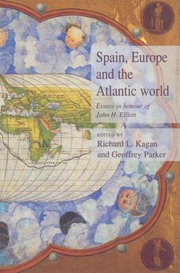Book contents
- Frontmatter
- Contents
- Notes on contributors
- Acknowledgements
- List of abbreviations
- Sir John Elliott: an appreciation
- Introduction
- PART I Power and propaganda: the world of the court
- 1 Twin souls: monarchs and favourites in early seventeenth-century Spain
- 2 Taxation and political culture in Castile, 1590–1640
- 3 Clio and the crown: writing history in Habsburg Spain
- PART II The pattern of society: community and identity in Habsburg Spain
- PART III Spain and its empire
- Index
3 - Clio and the crown: writing history in Habsburg Spain
Published online by Cambridge University Press: 04 August 2010
- Frontmatter
- Contents
- Notes on contributors
- Acknowledgements
- List of abbreviations
- Sir John Elliott: an appreciation
- Introduction
- PART I Power and propaganda: the world of the court
- 1 Twin souls: monarchs and favourites in early seventeenth-century Spain
- 2 Taxation and political culture in Castile, 1590–1640
- 3 Clio and the crown: writing history in Habsburg Spain
- PART II The pattern of society: community and identity in Habsburg Spain
- PART III Spain and its empire
- Index
Summary
Veo con mucha simpatía este amor que sientes por Córdoba, tu patria chica, que tanto se refleja en tu última carta.
I am very sympathetic to the love that you feel for Cordoba, your home town, which is expressed so well in your last letter.
Juan Ginés de Sepúlveda to Francisco de Argote (1552)Writing in 1789, León de Arroyal, one of the lesser-known figures of the Spanish Enlightenment, offered a somewhat unusual vision of his country at a moment when the centralizing policies of Spain's Bourbon monarchy were in full force: ‘We ought to consider Spain’, he wrote, ‘as a country composed of various confederated republics united under the government and protection of its monarchs. We should imagine each town as a miniature kingdom, and the kingdom itself as a large town.’
For all its boldness, Arroya's idea of a confederate Spain, a union of independent city-states or republics, actually belongs to a deep current in Spanish cultural and political life that John Elliott has conceived in terms of the vital and sometimes conflicting tensions between centre and periphery. Other essays in this volume examine the extent to which this enduring theme in Spanish history manifested itself both culturally and politically. This essay addresses the question of centre versus periphery from a historiographical perspective and aims to compare the history produced by the monarchy's official chroniclers – the cronistas del rey – with that written for individual cities and towns.
- Type
- Chapter
- Information
- Spain, Europe and the AtlanticEssays in Honour of John H. Elliott, pp. 73 - 100Publisher: Cambridge University PressPrint publication year: 1995
- 15
- Cited by



